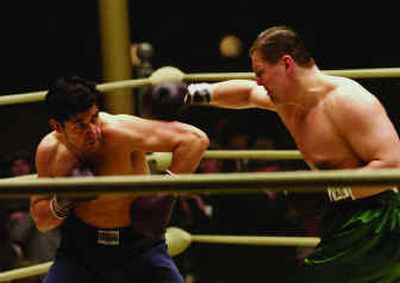Crowe lands knockout with ‘Cinderella Man’

Whatever else you can say about it, and you can say plenty, boxing remains the essence of sport.
Football? Sure you carry a ball, but the idea is to knock somebody down so that you can run from here to there. Hockey? Please. Basketball? Have you even seen the Detroit Pistons play?
No, it’s not as popular as it once was, but boxing – even more so than amateur wrestling or the various martial arts – pits one athlete against the next, each punching until one is beaten. Sometimes, and often, unconscious.
That’s the backdrop against which you have to measure a film such as “Cinderella Man,” Ron Howard’s biopic of the one-time heavyweight champion of the world, James J. Braddock.
The other consideration, of course, is the time in which Braddock fought – 1926 to 1937. And that period, which includes the 1929 stock market crash and the Great Depression, is important because it’s what Howard (with the help of screenwriters Alvin Hollingsworth and Akiva Goldsman) uses to make “Cinderella Man” into a boxing equivalent of “Seabiscuit.”
Braddock (played convincingly by Russell Crowe) was a natural light-heavyweight. Standing nearly 6-feet-3 and weighing barely 190 pounds, he was an early success. But injuries, mainly to his hands, coupled with the same kind of severe economic problems facing the nation as a whole, put Braddock on the financial ropes. By the early ‘30s, he was struggling to find work on the docks by day, fighting – and often losing to pugs – at night.
Then he got his second chance. Upset wins over three highly regarded fighters landed him a 1935 fight with heavyweight champion Max Baer – a guy with a punch so hard that if you took one, as one wag put it, “you flew into the third row.” One of Baer’s opponents actually died of a concussion.
That’s the film that Howard makes: a fighter, dubbed “Cinderella Man” by sportswriter Damon Runyon for his rags-to- riches rise, struggling to support his family by stepping into the ring with a potential killer.
And as the movie would lead you to believe, the crowd – many of whom are as bad off as Braddock – gets solidly behind their working- class hero. “He raised a nation’s spirit,” reads the film’s tagline, “and gave us the strength to keep on fighting.”
See? “Seabiscuit,” right?
Despite Howard’s tendency to play with the truth (Baer was actually a popular guy and not the killer played here by Craig Bierko), “Cinderella Man” is Howard’s most straightforward film since “Apollo 13.” And showing a kind of humility that must be hard for him, Crowe is a natural as Braddock, both in the ring as a sturdy fighter and out as a loving father.
Other actors are less successful. Renee Zellweger tears up a lot as Braddock’s brave wife, Paddy Considine is cast as the obligatory radical-come-to-a-bad-end and Paul Giamatti plays Braddock’s manager at times as if he were Harold Hill looking for trombones to lead the big parade.
No matter. While “Cinderella Man” avoids the “Rocky” syndrome (which might not mean what you think), the film does have a feel of authenticity that is built around Crowe’s quiet intensity. It feels far shorter than its near-2 ½-hour running time.
And Howard manages to stage convincing boxing scenes that do make the sport appear as brutal as it really is. And always has been.